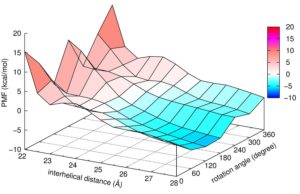June 26, 2020 — It’s common knowledge that the human body consists of trillions of cells. The cell nucleus, which houses DNA, is under attack every second of every day by environmental and behavioral factors. Researchers from Harvard University and the University of Texas Medical Branch at Galveston (UTMB) recently used the Comet supercomputer at the San Diego Supercomputer Center (SDSC) at the University of California San Diego to uncover the novel ways in which DNA prepares itself for repair.

Published in the Physical Review E journal, the study started with two DNA strands soaked in saltwater solution. The scientists watched as the DNA strands twisted and moved toward one another, due to water molecules and nearby sodium ions. The study was unique in that the research team used Comet to show specifics on how the molecules interacted with one another in order to line up before repair. While previous experiments primarily focused on potential mechanisms to demonstrate the interactions of larger DNA strands, these calculations used shorter models to get a closer look at the actual details of the process.
“The interactions or free energies found in our study were proven to be caused by certain structures in the surrounding water molecules and sodium ions,” said Monte Pettitt, who directs the Sealy Center for Structural Biology and Molecular Biophysics at the University of Texas Medical Branch at Galveston. Pettitt is also the Robert A. Welch Distinguished University Chair in Chemistry and further explained that the charges and electrostatics in solution of these molecules allowed them to interact with the phosphates within the DNA.
Before being placed in the solution, the DNA strands repelled one another. Once placed in the solution, the free energy allowed the molecules to sometimes locally attract one another in a geometrically and sequence-specific way. Using Comet to conduct highly detailed simulations allowed the researchers to calculate the exact amount of free energy needed for these two DNA double helices to interact with one another.
“Our simulations showed the free energy available relative to the specific rotation angle of the DNA strands as well as the distance between the strands,” said Pettitt. “This now helps researchers to understand how DNA interacts with itself in order to condense or separate during certain cellular processes.”
More specifically, the study showed how the local attraction of DNA to itself only occurs for certain geometries. Although this research is basic, it contributes to an important fundamental science discovery of how DNA is aligned before it is repaired. DNA strands within a cell are not protected from environmental factors such as UV radiation and carcinogens. This makes the DNA vulnerable in the sense that it can be damaged in a spot where repair enzymes will need a roadmap to repair it – that is, another piece of DNA with the same sequence that is geometrically lined up as a template for repair.
“We still need more work to understand the sequence specificity,” noted Pettitt. “The calculations to illustrate these concepts would not have been possible without Comet and we are appreciative of the ability it gave us to achieve our goal of furthering basic DNA research.”
This research was supported in part by The National Institutes of Health (NIH) (GM066813) and the Robert A. Welch Foundation. Computational time was allocated by the National Science Foundation’s Extreme Science and Engineering Discovery Environment (TG-MCA93S001).
About SDSC
The San Diego Supercomputer Center (SDSC) is a leader and pioneer in high-performance and data-intensive computing, providing cyberinfrastructure resources, services, and expertise to the national research community, academia, and industry. Located on the UC San Diego campus, SDSC supports hundreds of multidisciplinary programs spanning a wide variety of domains, from astrophysics and earth sciences to disease research and drug discovery. In late 2020 SDSC will launch its newest National Science Foundation-funded supercomputer, Expanse. At over twice the performance of Comet, Expanse supports SDSC’s theme of ‘Computing without Boundaries’ with a data-centric architecture, public cloud integration, and state-of-the art GPUs for incorporating experimental facilities and edge computing.
Source: San Diego Supercomputer Center



























































